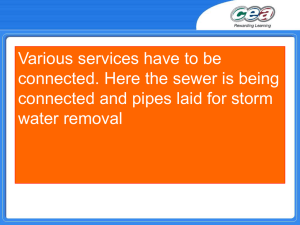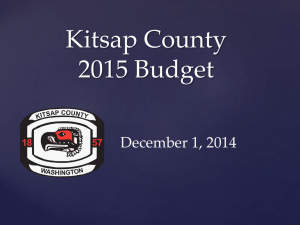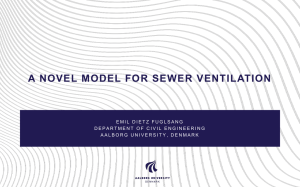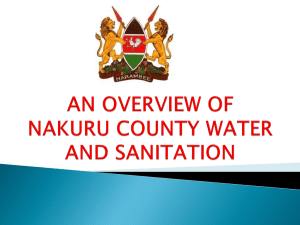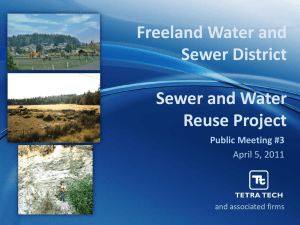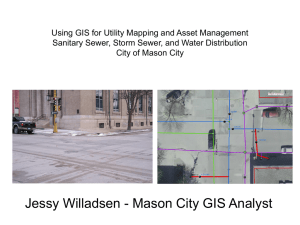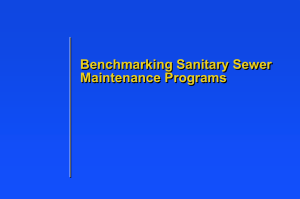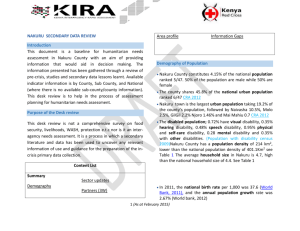implementation of corporate governance guidelines
advertisement
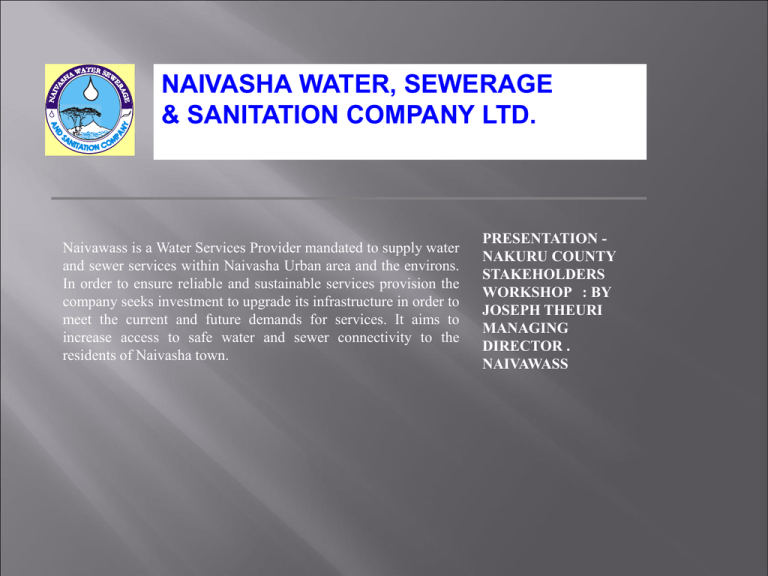
NAIVASHA WATER, SEWERAGE & SANITATION COMPANY LTD. Naivawass is a Water Services Provider mandated to supply water and sewer services within Naivasha Urban area and the environs. In order to ensure reliable and sustainable services provision the company seeks investment to upgrade its infrastructure in order to meet the current and future demands for services. It aims to increase access to safe water and sewer connectivity to the residents of Naivasha town. PRESENTATION NAKURU COUNTY STAKEHOLDERS WORKSHOP : BY JOSEPH THEURI MANAGING DIRECTOR . NAIVAWASS BACKGROUND Naivasha City is located on the shore of Lake Naivasha and along the Nairobi - Nakuru highway. It’s a fast growing urban centre within Nakuru County courtesy of flourishing floriculture industry that contributes approximately 3% of the Country’s GDP, employs over 50,000 people. It has also of late become attractive to investors in manufacturing, tourism, and geothermal production. Naivasha City is located on the shore of Lake Naivasha and along the Nairobi - Nakuru highway. It’s a fast growing urban centre within Nakuru County courtesy of flourishing floriculture industry that contributes approximately 3% of the Country’s GDP, employs over 50,000 people. It has also of late become attractive to investors in manufacturing, tourism, and geothermal production. Of the 375,000 people in Naivasha District (Census 2009), approximately half of them reside within the urban area. Naivasha Water and Sanitation Company (NAIVAWASS) is the mandated Water Services Provider in this area - serving Naivasha town and a growing number of formal and informal settlements, currently ten. With an average population of 8000 people, The Company is responsible for water production and distribution, wastewater collection and treatment, network operation & maintenance. NAIVAWASS aims to serve a growing number of un/underserved people in its service area. For Naivasha town, NAIVAWASS abstracts water from six abstraction locations with a total of 12 boreholes with depths ranging from 20 to 100 m. 4 However not all boreholes are operational since the system can not adequate absorb and distribute all the produced water. The customer connectivity for services is low. At the same time most of the abstraction sites yield water with high fluoride levels (beyond the recommended World Health Organization standards. So water from these sites is either used sparingly (blending with that from other sires) or pretreated which is quite expensive. 6 The water distribution network and the Sewer network require rehabilitation and extension to areas which are not served. The Sewerage Treatment Plant requires to be expanded to accommodate the current and anticipated increase in sewer inflow. THE FUTURE Within the next 2 years the company will be expected to serve more domestic and commercial customers and at the same time meet the growing needs of Industrial Customers. Keroche Breweries is among the key industrial customers the company is currently serving. April 13, 2015 Apart from our current production the company requires to produce 350 M3 /Hr in two years. In two years time Keroche Breweries alone is expected to increase its water demand by ten times from the current average of 25,000M3 per month. Consequently when we look at our current production capacity from six production sites we have 423m3 of water produced per hour. However among the six sites only two sites DTI and Karati has water which is not polluted with Fluorides. DTI and Karati sites can produce only 224m3 per hour. Hence when you look at the bigger picture, we have available 4500 M3 per day of fluoride free water that can be availed to the residents but this is not happening due to the existing design of our Network which can be addressed by investing in further extensions from the two sites. It’s important to note that the water demand for Naivasha urban area stands at 8,000 m3 per day. Unfortunately, as much as we can produce the amount albeit not of good quality we are yet to meet the demand since we have enormous gaps in our distribution network that contribute to low accessibility of services. Hence we have to deal with the issue of investment in Water production and distribution at the same time. Going by the forecasted demand we need to produce 350m3 per hour or more above the current production. If we were to target get our water from only the sites with quality water we can have each borehole at DTI producing 70m3 per hour and at Karati the average production per Borehole is 38m3 per hr. The other option we have to abstract water for Naivasha can include surface water from a proposed Dam to be constructed at Gitiri Dam. A pre-feasibility study has been done but we require a more elaborate study to enable us make appropriate justification of getting water from the Dam.(The cost of putting up the Dam and the transmission lines was put at around Kshs. 1.2 Billion). Back to the issue of Boreholes, our proposal is to bridge the demand gap by getting more water that is at least, 210m3/hour at DTI and 140m3/hour at Karati production site. Hence we will require drilling three Boreholes at DTI and 4 others at Karati going by the anticipated average yield of each borehole. So for the time being, we will go with the option of using ground water sources. Apart from drilling the boreholes we need to develop the distribution network and at the same time we need to rehabilitate the existing network which is highly dilapidated. We also have to identify gaps existing in our current service area which are not adequately served. We have to address the issue of managing loss of water through leaks and bursts that is currently significantly contributing to the Non-Revenue water by replacing old and spaghetti Network of pipes in identified zones. Below are estimates for the necessary activities. Drilling boreholes (7) 17,500,000 Developing Transport lines 198,750,000 Extending network services 105,089,000 Reservoirs (2) 5,000,000 Subtotal 326,339,00 Add 15% Consultancy 49,950,850 Add 16% Contingencies 52,214,240 Total sewer cost is 427,504,090 Currently our sewerage system has overstayed its project life. While the Company has a reticulated system the direct accessibility of services is limited to below 30%. However a good number of the rest make use of septic and the Exhauster Service is a Booming business. The exhaust is eventually offloaded into our Sewerage Treatment Plant by private vendors. The capacity of our plant is totally inadequate together with our sewer network since it was meant to cater for a smaller population than the current which is about 10 times more. As previously indicated a proper more detailed study is required to establish whether to develop a totally new system or upgrade the current one. The first option can be a longer term option compared to the second option Our current system is highly overloaded due to the design capacity which has been overtaken by population growth. At the same time the Municipal Council overtime have accommodated residents to connect storm water into our system. When it rains the system can’t cope and due to overloading the sewer spill all over creating a lot of filth mostly in the CBD? As the company plans to expand and extend the sewer network, the county Government of Nakuru who carries, the storm water management mandate requires investing in storm water drainage channels which are inadequate. In most areas the developers are left with the only option of draining the storm water into our system which is meant to handle sewer only. However over time even where drainage channels may be available the residents tend to be allowed to release water into the sewer system. We would urge the County Government to devise a strategy enforce disconnection of such connections since the buildings designs and construction had already been approved by the preceding Municipal Council to have the storm water finding its way into the Sewer system. As mentioned eelier for us to come up with reasonable proposals we are handicapped by lack of all the information to determine whether to go for the option of putting up a totally new system which will include relocating the treatment works to a site which is the Western part of the Town (lower grounds and also off the wind). This would address the issue of smell which is all over the town whenever the wind blows and we are doing aeration. The other option would be to upgrade our current system to urgently address the enormous gaps which include:Extension of services Narrow sewer pipes Redesigning of the system in some areas (to address gradient issue). Putting up additional ponds /wetlands Fencing etc. Below are estimates for the key activities: Extension Kayole/ sewer line 30,531,000 Extending the existing network 295,660,000 Putting new sewer ponds 90,916,000 Disludging the existing pond 2,000,000 Sub Total 419,927,000 Add 15% Consultancy 62,866,050 Add 16% Contingencies 67,057,120 Total for sewer is 549,030,170 Conclusion The total investment required to improve our water and sewer system during the next two years will be:- Water kshs Sanitation Kshs 427,504,090 549,030,170 Grand Total Kshs. 976,534,260 1.Existing water production System 2. Proposed water production plan 3. Budget Estimates 4. Sample Base prices 5. Water Estimates 6. Sewer Estimates

